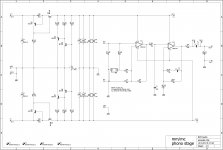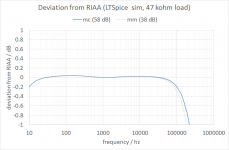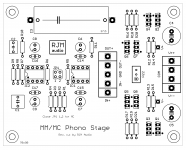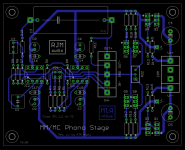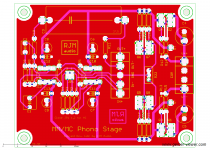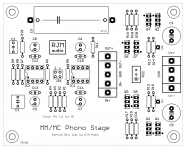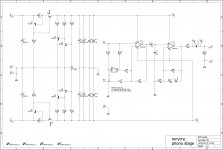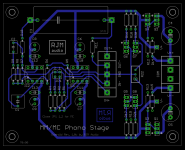A new circuit from me, I'm posting it give it a public timestamp.
Two stage active/passive phono pre-amplifier. The main point is the simple jumper switch between MM and MC configuration. It's also a well-balanced circuit from a noise/drive aspect at both gain settings and has very accurate RIAA response invariant of switch position. mm is 38 dB, 47k input, mc is 58 dB, 100 ohms input. S-Reg voltage regulation.
Two stage active/passive phono pre-amplifier. The main point is the simple jumper switch between MM and MC configuration. It's also a well-balanced circuit from a noise/drive aspect at both gain settings and has very accurate RIAA response invariant of switch position. mm is 38 dB, 47k input, mc is 58 dB, 100 ohms input. S-Reg voltage regulation.
Attachments
Last edited:
update to 10c, BOM uploaded
(Jumper positions switched, capacitor parts numbers fixed)
(Jumper positions switched, capacitor parts numbers fixed)
Attachments
Last edited:
Hi,
sorry, but I think it has certain issues.
- the OPA134, beeing a JFET-input OPA has typically highish voltage noise and very low current noise. The former plays a dominant role in MC application and in MM-application below ~2kHz. The figures of >>5nV/sqrHz are not noise-transparent any more (not yet taken into account the rather high 1/f intercept point). For MC useage where one rather aims for sub-1nV figures it'll be even more something like a noise generator. IIrc a LME49710 would be the better choice for the first stage (not really MC capable too)
- also regarding noise ... its common to design a great deal of the amplification into the first stage. This design though rather functions like buffer than an amplifier (A=2.5, adding ~20dB in MC mode). This has probabely been done so to keep the gain in MC mode at a reasonably low value as to preserve sufficient bandwidth .... It'd been advantageous to omit with the MC mode alltogether and to give the first gain stage more gain and add a dedicated MC prepre stage with a LT1115 for example.
jauu
Calvin
sorry, but I think it has certain issues.
- the OPA134, beeing a JFET-input OPA has typically highish voltage noise and very low current noise. The former plays a dominant role in MC application and in MM-application below ~2kHz. The figures of >>5nV/sqrHz are not noise-transparent any more (not yet taken into account the rather high 1/f intercept point). For MC useage where one rather aims for sub-1nV figures it'll be even more something like a noise generator. IIrc a LME49710 would be the better choice for the first stage (not really MC capable too)
- also regarding noise ... its common to design a great deal of the amplification into the first stage. This design though rather functions like buffer than an amplifier (A=2.5, adding ~20dB in MC mode). This has probabely been done so to keep the gain in MC mode at a reasonably low value as to preserve sufficient bandwidth .... It'd been advantageous to omit with the MC mode alltogether and to give the first gain stage more gain and add a dedicated MC prepre stage with a LT1115 for example.
jauu
Calvin
@anatech
Of the two-stage op amp phono stage circuits, there are what I'll call "the LM833 derivatives" (active RIAA in first stage, passive RC interstage filter, flat output buffer) from the LM833 datasheet and the more common "passive interstage RIAA" types which feature in the OPA606 datasheet. Both are presented as MM stages only.
My approach is more along the lines of putting variable gain head amp in front of a VSPS. Compared to a regular VSPS though the high frequency RIAA cut is moved out of the VSPS feedback loop and into the interstage region, the low impedance drive of the input op amp being wasted otherwise.
It ends up close to the LM833 circuit, I admit, just with the bass boost part of the eq. moved from the input to the output, and the coupling cap from the interstage to the output. As you suggest, there are only so many different approaches to solving this. The LM833 circuit does not, however, have provision for MC gain out of the box, and the all passive circuits, due to their greater inefficiency, are not MC compatible without a separate head amp / step up transformer.
@Calvin
It's true I hadn't thought too much about what op amps to use. The OPA134 just kinda ended up there as a holdover, I use OP27 for the input stage of MC amp usually. Though with a dual purpose design some compromise here is inevitable. Re. your second comment, in MC mode the midband gain is split evenly 30/30 dB between the two stages. For MM it is less, but again, the output is just a VSPS which normally does double duty covering both amplification and output drive. Here, some of the gain is farmed out to the input, so compared to the normal VSPS it has better performance.
Of the two-stage op amp phono stage circuits, there are what I'll call "the LM833 derivatives" (active RIAA in first stage, passive RC interstage filter, flat output buffer) from the LM833 datasheet and the more common "passive interstage RIAA" types which feature in the OPA606 datasheet. Both are presented as MM stages only.
My approach is more along the lines of putting variable gain head amp in front of a VSPS. Compared to a regular VSPS though the high frequency RIAA cut is moved out of the VSPS feedback loop and into the interstage region, the low impedance drive of the input op amp being wasted otherwise.
It ends up close to the LM833 circuit, I admit, just with the bass boost part of the eq. moved from the input to the output, and the coupling cap from the interstage to the output. As you suggest, there are only so many different approaches to solving this. The LM833 circuit does not, however, have provision for MC gain out of the box, and the all passive circuits, due to their greater inefficiency, are not MC compatible without a separate head amp / step up transformer.
@Calvin
It's true I hadn't thought too much about what op amps to use. The OPA134 just kinda ended up there as a holdover, I use OP27 for the input stage of MC amp usually. Though with a dual purpose design some compromise here is inevitable. Re. your second comment, in MC mode the midband gain is split evenly 30/30 dB between the two stages. For MM it is less, but again, the output is just a VSPS which normally does double duty covering both amplification and output drive. Here, some of the gain is farmed out to the input, so compared to the normal VSPS it has better performance.
Last edited:
IIrc a LME49710 would be the better choice for the first stage (not really MC capable too)
An OPA134 is indeed not a good choice for a MC amp, but your alternative is not that good either. The current noise of an LME49710 is a bit high for MM and the voltage noise is a bit high for MC. (See http://www.diyaudio.com/forums/analogue-source/313023-lme49710-phono-stage-2.html#post5205563 for details.)
That opamp isn't good choice for anything..An OPA134 is indeed not a good choice for a MC amp
I use VSPS as MC phono, 65dB gain with AD797, work excellent..
Simple R1-R2 value change and one can use it as MM/MC..
AD797 is great for MC, but not for MM: 2 pA/sqrt(Hz) of input noise current.
Noisewise the very worst MM amplifier ever is probably the moving-magnet version of the Elektor Supra 2.0: four LT1028s in parallel, which reduces the op-amp noise voltage from 0.9 nV/sqrt(Hz) to 0.45 nV/sqrt(Hz), but increases the op-amp noise current from 3.25 pA/sqrt(Hz) to 6.5 pA/sqrt(Hz).
(The LT1028 datasheet says 1 pA/sqrt(Hz), but that only applies when the impedances driving the positive and negative inputs are equal, which they never are in a real-life application; a graph at the back of the datasheet shows that with unmatched inpedances it is 3.25 pA/sqrt(Hz).)
Noisewise the very worst MM amplifier ever is probably the moving-magnet version of the Elektor Supra 2.0: four LT1028s in parallel, which reduces the op-amp noise voltage from 0.9 nV/sqrt(Hz) to 0.45 nV/sqrt(Hz), but increases the op-amp noise current from 3.25 pA/sqrt(Hz) to 6.5 pA/sqrt(Hz).
(The LT1028 datasheet says 1 pA/sqrt(Hz), but that only applies when the impedances driving the positive and negative inputs are equal, which they never are in a real-life application; a graph at the back of the datasheet shows that with unmatched inpedances it is 3.25 pA/sqrt(Hz).)
I'm thinking about sound.. noise isn't problem for MM phono, as for MC..AD797 is great for MC, but not for MM
Nonetheless, here's my point of view:
On one hand the record surface noise tends to dominate by a very large factor when I play dusty old records from the 1970's using an MM cartridge and a carefully noise-optimised amplifier. Under those circumstances a somewhat less noise-optimised amplifier would do just as well. The difference between the noise with the record playing and not playing is, of course, much smaller with clean brand new records.
On the other hand, a common target for the noise of an amplifier for MC cartridges is around 1 nV/sqrt(Hz) or less. As far as I know MM cartridges typically produce about ten times as much signal voltage as MC cartridges, so you would need around 10 nV/sqrt(Hz) or less for an MM cartridge to get the same signal to noise ratio (I will neglect the thermal noise of the cartridges themselves and of the termination resistors for simplicity, even though that's not necessarily correct).
As explained in the link http://www.diyaudio.com/forums/analogue-source/313023-lme49710-phono-stage-2.html#post5205563 , 1 pA/sqrt(Hz) of noise current has about the same impact as 12 nV/sqrt(Hz) of noise voltage when you have a 500 mH MM cartridge. With the 2 pA/sqrt(Hz) noise current of an AD797 you are therefore likely to get less signal to noise ratio with an MM cartridge than with an MC cartridge, at least with MM cartridges with a fairly high inductance.
On one hand the record surface noise tends to dominate by a very large factor when I play dusty old records from the 1970's using an MM cartridge and a carefully noise-optimised amplifier. Under those circumstances a somewhat less noise-optimised amplifier would do just as well. The difference between the noise with the record playing and not playing is, of course, much smaller with clean brand new records.
On the other hand, a common target for the noise of an amplifier for MC cartridges is around 1 nV/sqrt(Hz) or less. As far as I know MM cartridges typically produce about ten times as much signal voltage as MC cartridges, so you would need around 10 nV/sqrt(Hz) or less for an MM cartridge to get the same signal to noise ratio (I will neglect the thermal noise of the cartridges themselves and of the termination resistors for simplicity, even though that's not necessarily correct).
As explained in the link http://www.diyaudio.com/forums/analogue-source/313023-lme49710-phono-stage-2.html#post5205563 , 1 pA/sqrt(Hz) of noise current has about the same impact as 12 nV/sqrt(Hz) of noise voltage when you have a 500 mH MM cartridge. With the 2 pA/sqrt(Hz) noise current of an AD797 you are therefore likely to get less signal to noise ratio with an MM cartridge than with an MC cartridge, at least with MM cartridges with a fairly high inductance.
Last edited:
@MarcelvdG
First I'd like to point out that it's a socketed IC and anyone can use whatever op amp they want. I'd probably use NE5534A for both IC, as being a good compromise input op amp for both mm and mc cartridges and a low distortion and low noise driver for the output stage too, though I like the OPA134 sound too - it's just not ideal for mc input stage. Of course the LME49710 is up the task. (I have trialed the LME49710 in my Asus sound card and, iirc, one of my headphone amps and it did not win me over I'm afraid.)
Second, I'm going to have to side with vulejov on this one. In general the noise value of the op amp in an mm phono stage isn't the primary concern like it is for a mc stage. And even in an mc stage, at the end of the day it's whatever sounds best - if that means an op amp with 3 dB or 6 dB higher noise floor, so be it. For an mm stage, with a cartridge impedance of 500-1000 ohms, the total input referred noise doesn't change so drastically depending on the op amp used. Most audio opamps will still give better S/N with a high output mm cart than even the lowest noise op amp with an mc cart and as your own numbers confirm, even for the AD797 the current noise wouldn't be so bad as to make it unusable in that role - the end result is about the same S/N as obtained with mc.
First I'd like to point out that it's a socketed IC and anyone can use whatever op amp they want. I'd probably use NE5534A for both IC, as being a good compromise input op amp for both mm and mc cartridges and a low distortion and low noise driver for the output stage too, though I like the OPA134 sound too - it's just not ideal for mc input stage. Of course the LME49710 is up the task. (I have trialed the LME49710 in my Asus sound card and, iirc, one of my headphone amps and it did not win me over I'm afraid.)
Second, I'm going to have to side with vulejov on this one. In general the noise value of the op amp in an mm phono stage isn't the primary concern like it is for a mc stage. And even in an mc stage, at the end of the day it's whatever sounds best - if that means an op amp with 3 dB or 6 dB higher noise floor, so be it. For an mm stage, with a cartridge impedance of 500-1000 ohms, the total input referred noise doesn't change so drastically depending on the op amp used. Most audio opamps will still give better S/N with a high output mm cart than even the lowest noise op amp with an mc cart and as your own numbers confirm, even for the AD797 the current noise wouldn't be so bad as to make it unusable in that role - the end result is about the same S/N as obtained with mc.
Last edited:
He said AD797 was ideal for mc stage. As I read it he didn't suggest it would be good for mm, though as your numbers confirm, the current noise wouldn't be so bad as to make it unusable in that role.
In reality LP surface noise swamps many evils.
@MarcelvdG
(...) For an mm stage, with a cartridge impedance of 500-1000 ohms, the total input referred noise doesn't change so drastically depending on the op amp used. Most audio opamps will still give better S/N with a high output mm cart than even the lowest noise op amp with an mc cart and as your own numbers confirm, even for the AD797 the current noise wouldn't be so bad as to make it unusable in that role - the end result is about the same S/N as obtained with mc.
You are making the common mistake of underestimating the impedance of an MM cartridge. A 600 ohm plus 500 mH cartridge has an impedance that varies between 600 ohm and 63 kohm from 20 Hz to 20 kHz. When you calculate an RIAA- and A-weighted average, you find about 12 kohm.
Hi,
also keep in mind, that the current noise figures in Datasheets typically are lower than the real figures.
Due to the testing procedure it´s roughly 70% of the real numbers and figures rise with unmatchted impedances at the inputs.
IIrc Mr. J.L.Hood claimed en values of <5nV/sqrHz and in values of <1.5pa/sqrHz to be acoustically transparent in MM applications.
jauu
Calvin
also keep in mind, that the current noise figures in Datasheets typically are lower than the real figures.
Due to the testing procedure it´s roughly 70% of the real numbers and figures rise with unmatchted impedances at the inputs.
IIrc Mr. J.L.Hood claimed en values of <5nV/sqrHz and in values of <1.5pa/sqrHz to be acoustically transparent in MM applications.
jauu
Calvin
But as you know with DIY 'acoustically transparent' is always trumped by 'satisfyingly excessive'
Hi Bill, English is an intriguing language and you are like a magician playing with its words.
It’s always a pleasure reading your comments.
Hans
- Status
- This old topic is closed. If you want to reopen this topic, contact a moderator using the "Report Post" button.
- Home
- Source & Line
- Analogue Source
- an mm/mc phono stage
